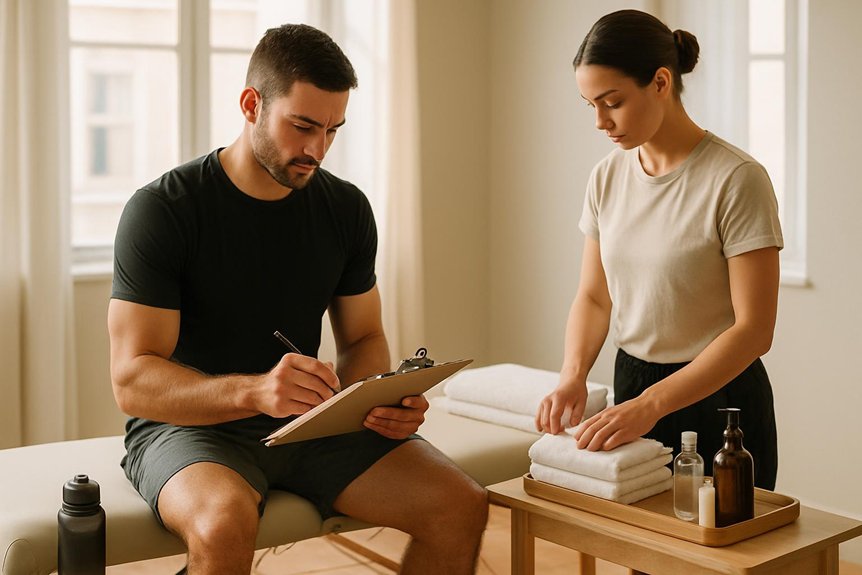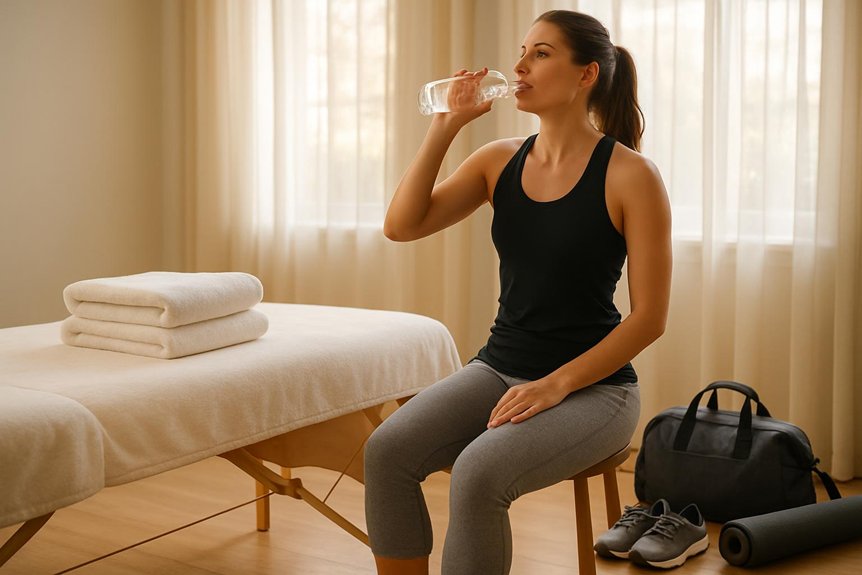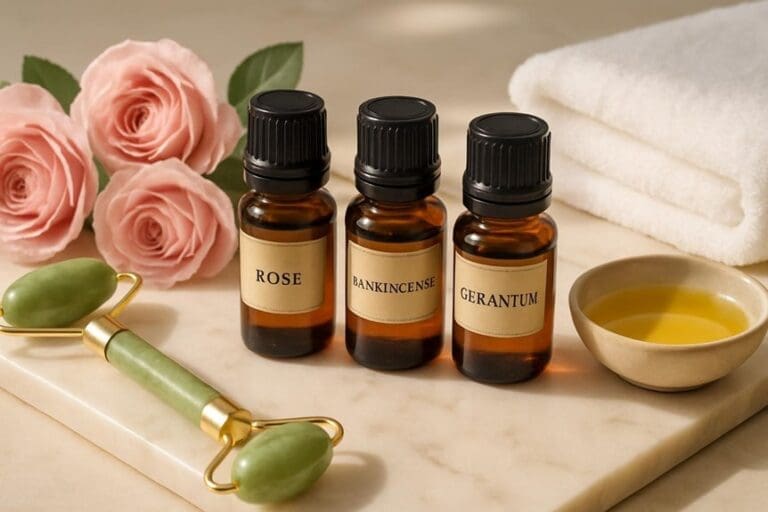To prepare for a massage session, schedule the session at least several hours after intense physical activity and guarantee proper hydration starting 24 hours prior. Eat a light, nutrient-rich meal 1–2 hours before the appointment. Wear loose, comfortable clothing and communicate injury history and treatment goals to the therapist. Bring a water bottle and, if needed, hypoallergenic massage oils. Mental preparation, such as relaxation techniques, also enhances outcomes. Further guidance is available for maximizing effectiveness and recovery.
Understanding the Purpose of a Sports Massage

Effectively, what distinguishes a performance massage from other modalities is its targeted approach to addressing musculoskeletal concerns related to physical activity.
At Spa & Massage, the primary objective is to facilitate ideal tissue recovery, improve flexibility, and reduce injury risk for both active individuals and athletes. Techniques such as deep tissue manipulation, trigger point therapy, and myofascial release are employed to resolve muscle tension and adhesions that can accumulate through repetitive movement or strenuous exertion.
Evidence indicates performance massage supports circulation, enhances lymphatic drainage, and may accelerate post-exercise recovery. In fact, some of these techniques overlap with those used in deep tissue massage, which is renowned for its ability to reach deeper muscle layers and relieve chronic pain.
In the hands of an experienced therapist, these methods are carefully adapted to the client’s specific needs, ensuring a personalised experience that fosters body awareness and promotes enduring physical wellbeing, both pre- and post-activity.
Choosing the Right Time for Your Appointment
Determining the ideal timing for a performance massage is a key factor in maximising its therapeutic benefits. At Spa & Massage, therapists advise scheduling appointments based on individual training cycles, event calendars, and recovery needs.
Evidence suggests that pre-event massages are best performed 24–48 hours before intense activity to prime muscles without inducing fatigue, while post-event sessions, ideally within 24–72 hours, support ideal recovery and reduction of muscle soreness.
For ongoing maintenance, regular sessions spaced according to training intensity and goals are recommended. Clients are encouraged to avoid booking immediately before rigorous physical activity or late at night, allowing time to rest and absorb the benefits.
Thoughtful appointment timing enhances both performance and well-being, supporting a personalised approach at Spa & Massage.
Communicating Your Needs and Goals
Effective communication with the therapist is essential to optimise the outcomes of a performance massage session. Clients should provide accurate information regarding previous injuries, current pain or discomfort, and specific performance objectives.
This helps facilitate a tailored treatment approach.
At Spa & Massage, this collaborative exchange enables therapists to select techniques and pressure levels that align with each individual’s therapeutic needs and athletic goals.
Sharing Previous Injuries Clearly
Why is it critical for clients to communicate previous injuries and specific concerns before a performance massage session? Disclosing injuries—whether acute or chronic—enables therapists at Spa & Massage to tailor techniques, pressure, and focus areas to the client’s unique anatomical landscape.
Evidence consistently demonstrates that targeted adjustments reduce the risk of aggravating vulnerable tissues while optimizing therapeutic outcomes. For instance, untreated muscle strains, ligament tears, or post-surgical areas require precise handling to support healing and avoid re-injury.
In our clinics, therapists integrate this information into a personalized treatment plan, fostering a sense of safety and trust. Clients who share their injury history openly experience enhanced comfort, as the therapist’s informed approach respects personal boundaries and cultivates a supportive environment for meaningful recovery and relaxation.
Outlining Performance Objectives
Beyond disclosing injury history, articulating specific performance objectives prior to a performance massage session is a foundational component of ideal care.
Clearly defined goals—such as enhancing flexibility, accelerating post-training recovery, or optimizing readiness for competition—enable therapists at Spa & Massage to select techniques and approaches that align precisely with each client’s aspirations.
Evidence suggests that tailored interventions yield superior outcomes in performance massage, as individual objectives guide the choice of pressure, rhythm, and targeted muscle groups.
In Spa & Massage clinics, clients are encouraged to communicate ambitions, whether seeking improved athletic performance or focused maintenance.
This collaborative dialogue fosters a bespoke experience, strengthening the therapeutic alliance and ensuring that each session is not only technically proficient but also deeply responsive to personal needs and intentions.
Describing Pain or Discomfort
How can ideal results be achieved during a performance massage session? Accurate communication of pain or discomfort is essential.
At Spa & Massage clinics, therapists encourage clients to articulate the precise location, intensity, and nature of any discomfort—whether it is sharp, dull, radiating, or intermittent. Evidence suggests that clear descriptions enable therapists to select appropriate techniques and pressure levels, thereby enhancing therapeutic efficacy and minimizing risk.
Clients are invited to express sensitivities or previous injuries, fostering an atmosphere of trust and safety. This open dialogue ensures the therapeutic intervention is both targeted and responsive to individual needs.
Ultimately, the attentive communication of pain fosters a more personalized, effective experience, aligning with Spa & Massage’s commitment to client intimacy, comfort, and ideal recovery outcomes.
What to Wear for Your Session
When preparing for a performance massage session, appropriate attire is essential to facilitate both comfort and effective treatment. Spa & Massage recommends clients wear loose-fitting, easily removable clothing such as athletic shorts or underwear for lower body work.
A sports bra or tank top is suggested for upper body access. This allows targeted muscle groups to be reached while maintaining the client’s dignity and fostering a sense of safety.
Fabrics should be breathable and non-restrictive, minimizing friction and ensuring suitable therapist access. In clinical settings, towels and draping techniques are used to preserve modesty, supporting a trusting environment.
Clients are encouraged to communicate any personal preferences regarding undress, as our therapists prioritize both therapeutic efficacy and client comfort throughout the entire session, aligned with Spa & Massage’s commitment to sensitive, individualized care.
Hydration and Nutrition Before Your Massage
Proper hydration and balanced nutrition are essential for maximizing the benefits of a performance massage.
Spa & Massage therapists advise clients to consume water at regular intervals leading up to their session.
They also recommend eating a light, nutrient-rich meal one to two hours beforehand.
These practices support ideal muscle function and help minimize discomfort during treatment.
Optimal Hydration Timing
Prior to a performance massage, adequate hydration is critical to support ideal muscle function and facilitate the body’s natural detoxification processes.
At Spa & Massage, therapists advise clients to begin hydrating well in advance of their scheduled session—ideally, increasing water intake 24 hours beforehand.
Scientific literature underscores that comprehensive cellular hydration enhances muscle pliability, reduces the risk of post-massage soreness, and aids in the effective removal of metabolic waste mobilized during treatment.
It is recommended to consume small, regular amounts of water rather than large volumes all at once, as this promotes better absorption and avoids discomfort.
Arriving for a massage neither dehydrated nor overly full ensures the body is prepared to fully benefit from the therapist’s techniques and the overall treatment experience.
Pre-Massage Meal Choices
How does nutritional timing impact the efficacy of a performance massage? Consuming a balanced meal one to two hours before a session can enhance circulatory and metabolic responses, supporting tissue recovery and comfort during treatment.
Evidence indicates that light, nutrient-dense foods—such as whole grains, lean proteins, and fruits—facilitate stable blood glucose and reduce gastrointestinal discomfort, boosting relaxation on the table.
At Spa & Massage, therapists advise avoiding heavy, greasy, or overly processed foods prior to appointments, as these may hinder comfort or impede ideal muscle pliability.
Adequate hydration, paired with mindful meal choice, ensures tissues remain supple and receptive.
Clients who observe these guidelines consistently report deeper relaxation and more effective results, reflecting the expertise and holistic philosophy practiced across all Spa & Massage locations.
Managing Pre-Massage Physical Activity

When preparing for a performance massage, it is essential to contemplate the intensity and timing of any physical activity undertaken beforehand. Engaging in strenuous exercise immediately prior to a session may heighten muscle fatigue and sensitivity, potentially diminishing the therapeutic benefits of the massage.
At Spa & Massage, therapists recommend allowing at least several hours between vigorous workouts and your scheduled appointment. This interval permits the body to begin its natural recovery processes and helps optimise circulation and tissue pliability.
Gentle movement, such as walking or light stretching, is generally favourable, as it maintains mobility without exacerbating muscle strain. By approaching pre-massage activity with intention, clients can enhance the effectiveness of the treatment, ensuring the therapist can address both acute discomfort and promote all-encompassing musculoskeletal recovery.
Preparing Mentally for Your Treatment
After thoughtful consideration of physical preparation, attention must also be given to the psychological state before a performance massage.
Evidence indicates that mental readiness can enhance the efficacy of manual therapy by reducing anticipatory tension and promoting parasympathetic activation.
At Spa & Massage, clients are encouraged to allocate time for quiet reflection or mindful breathing prior to arrival, fostering an internal environment conducive to relaxation and tissue receptivity.
Setting clear intentions for the session—such as targeting specific areas of discomfort or focusing on recovery—enables more effective communication with the therapist and maximizes therapeutic outcomes.
Visualizing positive results and maintaining an open, receptive mindset are associated with improved client satisfaction and perceived benefit.
This mindful approach supports holistic wellbeing, aligning with Spa & Massage’s philosophy of holistic care.
What to Bring to Your Performance Massage
Although performance massage is primarily a hands-on therapeutic intervention, ideal client experience and outcomes are influenced by preparedness regarding personal items.
At Spa & Massage, therapists recommend clients bring comfortable, loose-fitting clothing for post-massage comfort and easy changing.
A water bottle is advised, facilitating hydration following tissue manipulation.
For those with sensitive skin or allergies, personal massage oils or lotions are welcomed, though hypoallergenic products are standard in our clinics.
Clients may also wish to bring written notes of recent injuries, medical conditions, or specific treatment goals to enhance communication and personalisation.
Valuables should be minimized to ensure peace of mind.
This intentional preparation helps foster a secure and welcoming environment, promoting trust and relaxation throughout the session in alignment with Spa & Massage’s philosophy.
Aftercare Tips for Optimal Recovery
Following a performance massage, adherence to targeted aftercare protocols is essential for maximising therapeutic benefits and supporting tissue recovery.
Post-treatment guidelines at Spa & Massage include gentle hydration to facilitate metabolic waste removal and reduce post-massage soreness.
Clients are encouraged to rest and avoid intensive exercise for 24 hours, allowing muscle fibres to repair and adapt.
Application of a warm compress to specific areas may promote circulation and further ease residual tension.
Our therapists recommend light stretching and mindful movement to maintain flexibility without overexertion.
Monitoring for delayed onset muscle soreness is important; transient discomfort is normal, but persistent pain warrants consultation.
Conclusion
In conclusion, effective preparation for a performance massage—through hydration, appropriate attire, open communication, and mental readiness—has been shown to optimise therapeutic outcomes. Isn’t maximising the benefits of each session worth a few thoughtful steps? By following evidence-based guidelines and leveraging professional advice, clients at Spa & Massage can support recovery, enhance performance, and address muscular concerns more efficiently. Thorough preparation ensures both client and therapist can collaborate for the most productive and beneficial experience possible.



